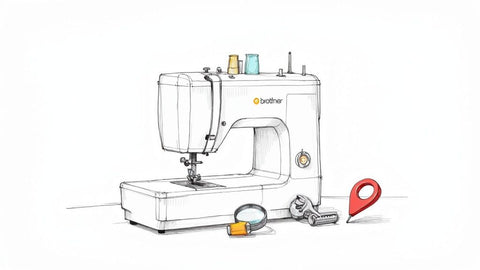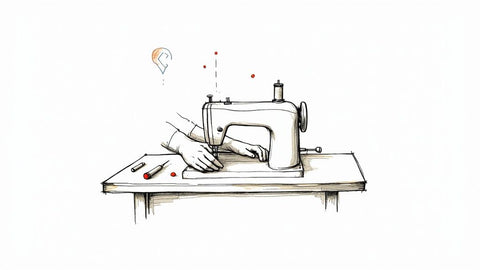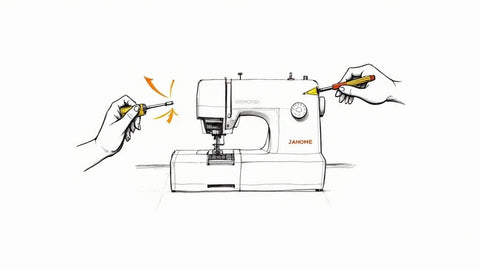We've all been there—that heart-sinking moment when your trusty Brother machine just... stops. One minute you're happily stitching along, and the next, a tangled mess or an ominous sound brings your project to a screeching halt. While many hiccups can be sorted out at home, some problems are really a job for an expert. Knowing where to find reliable Brother sewing machine repairs near me is the secret to getting back to your creative happy place without accidentally making things worse.
When Your Brother Machine Needs a Pro
Even a perfectly maintained sewing machine will eventually throw you a curveball that a new needle or a quick re-threading can't fix. Being able to tackle small fixes yourself is part of the sewing journey, but recognizing when it's time to call in a professional is just as important—it’s about protecting your investment. A good repair not only rescues your current project but can add years to your machine's life.
Here at bsewinn.com, we are deeply committed to empowering crafters. Our custom sewing machine designs are just the beginning. Through our extensive resources, online classes, and hands-on training, we provide the support you need to bring your vision to life. Part of that empowerment is knowing how to care for the machine you love, and that includes knowing when to let an expert take over.
Signs It's Time for an Expert Repair
Some issues are clear red flags that your machine needs a specialist. If any of these sound familiar, it’s definitely time to find a professional service:
- Stubborn Tension Troubles: You've tweaked the tension dials more times than you can count, swapped the needle, and re-threaded the entire machine, but your stitches are still a loopy, puckered disaster.
- Scary Noises: Any loud grinding, clunking, or high-pitched squealing is a bad sign. These sounds usually point to internal problems like timing being off or worn-out gears that you can't get to without taking the whole thing apart.
- Computer Glitches: If your digital display is flashing error codes that won't go away with a simple restart, it's a sign of a deeper electronic issue that needs a technician's touch.
It's no surprise that as the global sewing machine market grows—it's expected to hit USD 4.65 billion by 2025—so does the need for skilled repair techs. More and more people are choosing to maintain their beloved machines rather than replace them.
Knowing the difference between a simple bobbin jam and a serious timing issue can save you a world of headaches (and money!). Our guide on sewing machine service and repairs dives into this with a lot more detail.
Finding a Trusted Local Repair Technician
When your beloved Brother machine starts acting up, searching for "Brother sewing machine repairs near me" can feel a little overwhelming. Who can you trust? The best place to start is usually an authorized Brother dealer. These folks are factory-trained, so they know your machine inside and out and use genuine parts for repairs. It’s the surest way to get the specific care your machine needs.
But don't stop there! Your local fabric and quilt shops are often hidden gems. The people running these stores have been part of the sewing community for years and usually have a go-to technician they swear by. It might be someone in-house or an independent expert they’ve trusted with their own machines for ages.
This flow chart really captures that moment we all face: do I try to fix it myself, or call in a professional?
As you can see, while tinkering with it yourself is tempting, getting a pro involved is often the straightest line from frustration back to happy sewing.
Leveraging Your Sewing Community
Never underestimate the power of your fellow sewists. This is where you’ll find the real-deal, honest feedback.
Jump into online sewing forums or local Facebook groups and just ask! You’ll get firsthand reviews and sometimes discover amazing independent technicians who don’t have a big online presence. If you're looking for broader tips on finding and vetting local experts, you'll find that the same principles apply across different crafts.
A personal recommendation from someone who uses a similar Brother model is gold. They get the little quirks of the machines and know just how important precise, careful work really is.
At bsewinn.com, we want you to feel empowered. We're here to help you replicate beautiful designs and learn new skills through our online classes, but we also recognize the importance of a well-maintained machine. A trusted technician is a key part of your creative support system, ensuring your machine is always ready for your next project.
To help you decide where to begin your search, here's a quick look at the different ways you can find a local repair tech.
Comparing Local Repair Search Methods
Deciding where to look for a technician can be tricky. This quick-reference guide breaks down the pros and cons of the most common methods to help you find a qualified pro near you.
| Search Method | Pros | Cons |
|---|---|---|
| Authorized Dealer | You get guaranteed expertise with genuine parts, and the work is often under warranty. | Can be more expensive and sometimes have longer wait times due to high demand. |
| Local Quilt/Fabric Shop | Recommendations are built on strong community trust and have usually been vetted over time. | The technician might be a generalist, not necessarily a Brother-specific specialist. |
| Online Forums/Groups | You get access to a huge pool of honest, user-based reviews and hidden gems. | You'll need to do a bit more homework yourself to vet the recommendations. |
Ultimately, the best path depends on your specific needs, your machine's issue, and what's available in your area. Any of these routes can lead you to a fantastic technician who will get you back to your projects in no time.
How to Vet a Sewing Machine Repair Shop
So you've got a short list of potential technicians. Great start! Now comes the most important part: digging a little deeper to find the right person for the job. Finding a good shop for Brother sewing machine repairs near me is about more than just convenience; it's about finding real expertise and someone you can trust with your machine.
The best way to start is by asking some pointed questions. I always lead with, "Do you have specific experience with my computerized Brother model?" The guts of a simple mechanical machine are a world away from a high-tech embroidery unit. I've seen technicians with over 35 years of experience who still get tripped up by the newest models, so that specific knowledge is non-negotiable.
Next, talk about warranties. Any shop worth its salt will stand behind their work. A simple "Do you provide a warranty on your repair work?" tells you everything you need to know about their confidence in their own skills. It's your peace of mind and their accountability, all in one.
Reading Between the Lines of Online Reviews
Online reviews can be a goldmine of information, but you have to know how to sift through them. A bunch of "great service" comments are nice, but they don't really tell you anything useful.
I always hunt for the reviews that get into the nitty-gritty. Look for feedback that mentions things like:
- Accurate Diagnostics: Did they nail the problem on the first try, or was it a guessing game?
- Clear Communication: Did the customer feel like they were in the loop on costs and how long it would take?
- Problem Resolution: Did the fix actually last? This is a big one.
This is the kind of detail that paints a real picture of what your experience will be like, much more than a generic star rating ever could.
Understanding the Financial Side
Finally, let's talk about money, because nobody likes surprises here. Most shops will have what’s called a "bench fee." This is a non-refundable charge just for the technician to take a look at your machine and figure out what’s wrong. It covers their diagnostic time.
A key question to ask is whether this bench fee gets applied to the final repair bill if you move forward. A transparent, honest shop will always be upfront about this policy. It's a huge green flag.
Here at bsewinn.com, our goal is to empower you with comprehensive how-to guides and tangible examples that you can replicate. Our online training and extensive resources are designed to help you create stunning projects. But we also know that a well-serviced machine is the foundation of great work. By asking these questions, you can feel confident you're leaving your Brother machine in truly capable hands.
Understanding Common Repairs and Costs
So, you've searched for "Brother sewing machine repairs near me," and now you’re wondering what it's all going to cost. It’s the big question, right? Getting a handle on what goes into a repair quote can make the whole process feel less mysterious and help you budget for it.
Many of the most frustrating sewing machine problems are actually pretty routine for a good technician. I see it all the time. Timing adjustments are a classic—that’s when the needle and bobbin hook get out of sync and you start getting skipped stitches. It’s a frequent offender.
Another common culprit is a wonky tension assembly. It can get packed with lint or just knocked slightly out of whack, leaving you with a bird's nest of thread. Then there are feed dog issues. When they get stuck or misaligned, your fabric just won’t move, bringing your project to a dead stop.
What Goes Into a Repair Bill?
The final price on your repair ticket isn't just pulled out of a hat. A few key things really drive the cost, and knowing what they are will help you make sense of the estimate you receive.
- Your Machine's Model: Let's be honest, fixing a basic mechanical Brother is worlds away from repairing a top-of-the-line embroidery machine with a motherboard and complex sensors. The more tech, the more specialized the repair.
- Where You Live: It's a simple fact that labor rates are higher in big cities. A technician in downtown Manhattan will have different overhead than one in a small town, and that's reflected in the price.
- The Parts Required: Sometimes it's a simple adjustment; other times, you need a new part. The cost and availability of those replacement parts are a huge factor, especially for newer, more advanced models.
This is exactly why specialized knowledge is so important these days. An authorized technician isn't just a generalist; they have a direct line to genuine Brother parts and the specific training to deal with today’s intricate machines. That access often makes them the smartest, most reliable choice. You can get a better feel for this by checking out our detailed breakdown of sewing machine repair costs.
Think about it—the world of sewing machine components is booming. The market was valued at about USD 2.7 billion in 2025, and that growth is all about the demand for sophisticated parts inside our computerized machines. Repair shops have to source everything from smart motor systems to advanced sensors, and that takes real expertise. Future Market Insights has some fascinating data on just how fast this market is growing.
Prepping Your Machine for a Smooth Repair
Before you pack up your machine and head to the repair shop, taking a few minutes to get it ready can make a world of difference. Think of it as setting your technician up for success—it helps them diagnose the problem faster and gets your beloved machine back to you sooner.
First things first, give it a quick wipe-down. Just clearing away the surface dust and lint gives the technician a clean slate to work with and helps them spot any obvious external issues right away. It's a small gesture, but it shows you care for your equipment.
Next, round up the essentials. Your technician absolutely needs the power cord and the foot pedal to run the machine through its paces. It's also a great idea to bring the specific bobbin case that was in use when the trouble started.
What to Bring and What to Leave at Home
Knowing what to pack (and what to leave behind) will make the drop-off a breeze and prevent any important bits from getting lost.
- A Detailed Note: Be specific! Instead of just saying "it's broken," try something like, "It's making a clunking noise when the needle goes down, especially on thicker fabrics." The more detail, the better.
- A Fabric Swatch: If you're dealing with stitch issues, bring a scrap of the fabric and the thread you were using. This lets the tech recreate the exact conditions you were sewing in, which is a huge help for troubleshooting.
Just as important is what you don't bring. Leave your accessory box, extra presser feet, and that big extension table at home. Shops are busy places, and it's all too easy for small, valuable pieces to go missing.
Finally, if you’ve already tried a few things yourself, you might find some useful terms in our sewing machine troubleshooting guide to help you describe the issue to the technician.
Your Brother Machine Repair Questions Answered
Even with a solid plan, it's totally normal to have a few last-minute questions before you trust someone with your beloved sewing machine. Finding a great local technician is a big deal, and you want to feel good about your choice.
So, let's tackle some of the most common questions we hear from the sewing community. Think of this as your final check-in to make sure you know exactly what to expect.
How Often Should My Brother Machine Be Serviced?
This is a great question, and it really depends on how much you sew. If your machine is humming along almost every day, think of a professional service like an annual tune-up for your car. Once a year is a smart move.
For those of us who are more weekend hobbyists, you can stretch that out. Getting it looked at every 2-3 years is usually plenty to keep it in tip-top shape. This kind of preventative care is about more than just what's broken now. A good tech will get into the guts of the machine, cleaning out lint you can't reach, lubricating all the moving parts, and catching small issues before they become huge, expensive headaches.
Is It Worth Repairing an Older Brother Sewing Machine?
Oh, in most cases, absolutely! So many of the older Brother models are absolute workhorses, built with heavy-duty metal parts you just don't see anymore. They were truly made to last.
Here's my rule of thumb: if the repair costs less than 50% of what it would cost to buy a new, comparable machine, it's a fantastic investment. A skilled technician can often get that vintage beauty stitching just as perfectly as it did when it was brand new. Don't be so quick to write it off!
What's a "bench fee?" You'll probably hear this term. It's just a standard diagnostic charge that covers the technician's time to open up your machine and figure out what's wrong. It usually isn't refundable if you decide not to go through with the repair, but almost every shop will apply it toward your final bill if you give them the green light. Always ask about their policy upfront!
At the end of the day, a well-cared-for machine is a happy machine. And that means you can get back to what really matters—bringing all your creative ideas to life.
At bsewinn.com, we are dedicated to empowering your creativity at every turn. From providing custom sewing machine designs and extensive online resources to helping you care for your equipment, we're here to support your passion. Explore our wide range of products and classes to elevate your sewing journey at https://www.bsewinn.com.



